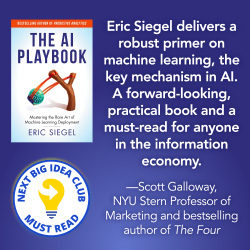On-Demand Webinar: Practical Customer Analytics using Predictive Approaches
 Are you using predictive approaches to truly leverage customer analytics? If not, I highly recommend this webinar where we’ll review predictive analytic approaches to common customer analytics tasks such as predicting likelihood to purchase or expected near-term customer value.
Are you using predictive approaches to truly leverage customer analytics? If not, I highly recommend this webinar where we’ll review predictive analytic approaches to common customer analytics tasks such as predicting likelihood to purchase or expected near-term customer value.
Presented by: Dean Abbott, Co-Founder and Chief Data Scientist, SmarterHQ & Dell Statistica
Predictive approaches include considerable data cleaning and preparation, building predictive models, and assessing the predictive models. At each stage of the process, practical tips for accomplishing these tasks will be described with specific “how to’s”. We will also discuss compromises that inevitably need to be made because of data problems and time pressures to deploy solutions to operational systems.
Dean Abbott is Co-Founder and Chief Data Scientist of SmarterHQ, and President of Abbott Analytics, Inc. in San Diego, California. Mr. Abbott is an internationally recognized data mining and predictive analytics expert with over two decades of experience applying advanced data mining algorithms, data preparation techniques, and data visualization methods to real-world problems, including fraud detection, risk modeling, text mining, personality assessment, response modeling, survey analysis, planned giving, and predictive toxicology






